能量收集认知无线电网络中的ris辅助传输:一种DRL方法
IF 3.2
3区 计算机科学
Q2 COMPUTER SCIENCE, INFORMATION SYSTEMS
引用次数: 0
摘要
在认知无线网络中,直接传输容易受到障碍物和信道不确定性的阻碍,因此认知发射机通常会增加发射功率以保证服务质量;然而,它会耗尽有限容量的电池,降低长期性能。这些问题可以通过使用可重构智能表面(RIS)将信号反射给认知用户(cu)并设置适当的传输功率来解决。本研究研究了RIS辅助非正交多址(NOMA) crn的下行链路,其中RIS可以重建传输环境,无线供电认知基站(CBS)机会性地使用许可信道,允许在相同的频率和时间块中进行多用户传输。在能量收集、无线信道和主要网络行为的随机特性下,我们的目标是优化cu和RIS相移的分配功率,以最大化crn的和速率。为此,我们将优化问题表述为马尔可夫决策过程(MDP)框架。随后,采用深度确定性策略梯度(deep deterministic policy gradient, DDPG)算法处理时变环境下的高维连续状态和动作空间。仿真结果证实了该方案优于考虑了正交多址(OMA)、长期和短视优化的基准方案。本文章由计算机程序翻译,如有差异,请以英文原文为准。
RIS-aided transmissions in energy-harvesting cognitive radio networks: A DRL approach
Direct transmissions in cognitive radio networks (CRNs) can be easily obstructed by obstacles and channel uncertainty and thus cognitive transmitters normally increase the transmission power to guarantee the quality of service; however, it can deplete limited-capacity batteries and degrade long-term performance. These issues can be solved by reflecting signals to cognitive users (CUs) using a reconfigurable intelligent surface (RIS) and setting appropriate transmission powers. This study investigates RIS-aided downlink of non-orthogonal multiple access (NOMA) CRNs, where RIS can reconstruct transmission environments and a wireless powered-cognitive base station (CBS) opportunistically uses a licensed channel allowing multi-user transmissions in the same frequency and time block. Under stochastic properties of energy harvesting, wireless channels, and primary network behavior, we aim to optimize the assigned power of CUs and RIS phase-shifts jointly to maximize the sum-rate of CRNs. To this end, we formulate an optimization problem as a Markov decision process (MDP) framework. Subsequently, a deep deterministic policy gradient (DDPG) algorithm is adopted to cope with highdimensional continuous states and action spaces in time-varying environments. Simulation results are presented to confirm the superior performance of the proposed scheme over benchmark schemes in which orthogonal multiple access (OMA), long-term, and myopic optimizations are considered.
求助全文
通过发布文献求助,成功后即可免费获取论文全文。
去求助
来源期刊
CiteScore
6.60
自引率
5.60%
发文量
66
审稿时长
14.4 months
期刊介绍:
The JOURNAL OF COMMUNICATIONS AND NETWORKS is published six times per year, and is committed to publishing high-quality papers that advance the state-of-the-art and practical applications of communications and information networks. Theoretical research contributions presenting new techniques, concepts, or analyses, applied contributions reporting on experiences and experiments, and tutorial expositions of permanent reference value are welcome. The subjects covered by this journal include all topics in communication theory and techniques, communication systems, and information networks. COMMUNICATION THEORY AND SYSTEMS WIRELESS COMMUNICATIONS NETWORKS AND SERVICES.

 求助内容:
求助内容: 应助结果提醒方式:
应助结果提醒方式:


